| A
R T I C L E S |
New Collectibles •05/25 - NECA Sesame Street: Count Von Count Ultimate Action Figure
•04/25 - Reaction Sesame Street: Big Bird and Snuffy •03/25 - NECA Sesame Street: Ernie Ultimate Action Figure, Bert Ultimate Action Figure
•03/25 - Boss Studios Fraggle Rock: Boober Action Figure, Wembley Action Figure, Mokey Action Figure, Sprocket Action Figure •08/24 - Reaction Sesame Street: Big Bird, Mr. Hooper, Sherlock Hemlock, Super Grover |
||
|
|
|

The Mouse & The Frog
Disney & Henson Join Empires
By
Bill Givens
Animation Magazine
Spring 1990
It’s an unusual day on the back lot of the Disney Studios in Burbank. Pyrotechnics experts are wiring up incendiary devices and air cannons, and a memo has been circulated to all offices on the lot, warning them to expect a series of explosions later in the day.
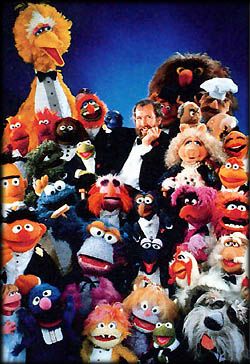 There’s
a bit of tension in the normally bucolic town square setting, which is
about all that remains of the Disney back lot. Gaily-dressed extras hang
around, playing cards, reading, waiting for the cameras to roll. Firemen
– both real ones and actors – lounge on the back of a Burbank
fire truck.
There’s
a bit of tension in the normally bucolic town square setting, which is
about all that remains of the Disney back lot. Gaily-dressed extras hang
around, playing cards, reading, waiting for the cameras to roll. Firemen
– both real ones and actors – lounge on the back of a Burbank
fire truck.
Nearby, construction workers are putting the finishing touches to Disney’s new corporate headquarters, a sandstone-colored modern monument on which the roof will be supported by statues of (ahem!)…the seven dwarfs. The brobdingnagian creatures (let’s face it – can you call a twenty-or-so foot statue a dwarf?) are covered by plastic tarps to hide them from prying eyes until the structure is ready for its public unveiling. The building and nearby parking structure have eaten up much of the studio’s back lot.
For the time being, there’s not a mouse in sight. The star of this production is a frog. A frog…on the lot built by a mouse. A brick wall is about to be blown to smithereens, and the crew is hustling about, making sure every little detail of the filming is locked down, every safely precaution is firmly in place.
The one person who doesn’t reflect any of the tension of the moment is Jim Henson. The bearded creator of “The Muppets”, who is directing the film, is an island of relaxation in the midst of all the frantic activity. Asked about his calm demeanor, the Muppet Master says, ”There’s not a lot that tension will do for us. There are times like this when I’ve done everything I can do, then I just sit back and wait for everybody else to get ready.”
The project that Henson is directing is a 3-D film, scheduled to become an attraction at the Disney/MGM Studio Tour in Florida. California’s Disneyland may have its hipper-than-thou Michael Jackson as a 3-D “Captain EO”, but Florida’s multi-dimensional image will be good ole lovable Kermit the Frog and his Muppet Friends.
Kermit, Miss Piggy, and all of the Henson characters are becoming a hard-working part of the Disney family in a buyout deal that has been estimated as worth $150 to $200 million dollars to Henson, even though neither party has quoted numbers.
While the production shuts down for a lunch break, Henson heads for Disney’s Rooftop Executive Dining Room for a fast lunch and a chance to talk about the way things will be going when his company becomes a part of Mickey’s empire.
Idea Came From Eisner
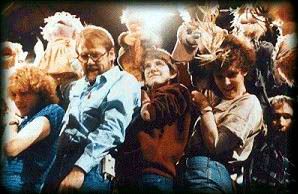 Henson
says that the idea of the merger started with a meeting with Michael Eisner
to discuss some joint projects, but before too long, the conversation
turned to a high-powered deal wherein Mickey’s empire takes over
Kermit’s domain.
Henson
says that the idea of the merger started with a meeting with Michael Eisner
to discuss some joint projects, but before too long, the conversation
turned to a high-powered deal wherein Mickey’s empire takes over
Kermit’s domain.
“It just grew out of a couple of conversations that Michael and I had,” Henson says. “I went to them to talk about hooking up in terms of other things that we could work on together, or that they could distribute a film of ours, things like that, then Michael sort of escalated the conversation into the topic of their taking over these characters. I was initially very surprised by the idea. It never would have occurred to me, but as we thought about it, it just made a lot of sense.”
The deal also made a lot of sense for Disney, says chairman Jeffrey Katzenberg. “Simply stated,” he said, “this is the perfect marriage for the Walt Disney Company. Jim Henson’s Muppet characters spell quality, family, and enormous popularity. There could not be a more productive association for our company.”
“We’ve had feelers in the past,” Henson adds, “but I’ve never been interested. I think Disney is the only place that has been of interest to me. People have tried to get our characters into theme parks and other things. I’ve never wanted to be in any other park because I think Disney does it so much better than anyone else. And I love Disneyland, Disney World. These are two of my favorite places. Being able to design things for those parks is really a lot of fun. I’m having a good time."
Deal Makes Sense
The deal makes much sense for Disney’s theme parks and licensing. For product licensing, it provides a universe of popular characters that have been the genesis of hundreds of best-selling products. For the theme parks – both domestic and foreign – it provides a host of new but well-known characters around which new rides and attractions can be built.
For The Disney Channel and Disney Home Video, it brings in programming ranging from 120 episodes of THE MUPPET SHOW – the most widely seen television show in the world (an estimate 235 million viewers in 100 countries during its five-year run) – as well as Henson’s award-winning library which includes five feature films and a raft of episodes of FRAGGLE ROCK, THE JIM HENSON HOUR, the MUPPET BABIES Saturday morning TV show, and other programming.
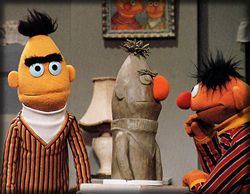 There
are but a few Henson creations that don’t go to Disney. “The
only thing that is separate from the deal,” Henson points out, “is
SESAME STREET. The copyrights are mine, but the control of those characters
is jointly between myself and SESAME STREET.”
There
are but a few Henson creations that don’t go to Disney. “The
only thing that is separate from the deal,” Henson points out, “is
SESAME STREET. The copyrights are mine, but the control of those characters
is jointly between myself and SESAME STREET.”
Henson’s new role in the operation frees him from administrative detail to focus on creating and directing – or, as Eisner told an interviewer, "Henson can now become a creative designated hitter.”
“We’ve cut down the size of our company,” Henson adds. “That helps with the administrative work. Because they’ve taken over our licensing, our international distribution, our publishing and a lot of legal work connected to all those areas, we’ve been able to reduce the size of the company a great deal. We are really production and creative now.”
Henson says that the number of his company’s employees, which he estimates peaked at about 110 in the United States and 10 or 30 in the United Kingdom is down to about 70 now, most of whom will be absorbed into Disney.
Henson’s deal with Disney includes a 15-year contract for his creative services and a production deal with the studio. “My company has signed a production deal with them,” Henson says. “So I’m still working, I still have my own company, but our output is exclusive to Disney.”
Need For Product
“Mostly what this whole thing is now, as far as I’m concerned, is that instead of trying to sell products, I now am dealing with a company that has a need for a lot of product. A good deal of my work used to be in pitching things to different people and trying to get them on the air. Here, since we’re dealing with a company that needs a lot of product, I see us for the next couple of years being busier than we ever have been, in terms of production.”
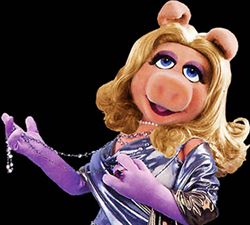 “And”,
he says with a smile, “That’s what makes me happiest. That’s
what I like doing the most.”
“And”,
he says with a smile, “That’s what makes me happiest. That’s
what I like doing the most.”
Henson’s already-busy production slate is brimming over with Disney-related projects. Among the projects he lists is a nature series for The Disney Channel, using an entirely new group of characters.
“They would like another ‘Muppet Movie’, so we’re working on a couple of ideas on that right now,” he points out. “Hopefully, about this time next year we may be shooting a Muppet film. And we’re also working on a couple of other movie ideas, non-Muppet but creature-oriented.”
The deal also opens the resources of Disney’s vaunted Imagineering Department to Henson. Asked if his operations would be separate from those of Disney’s Imagineering, he says, “No, we’re working together very much with Imagineering, Certainly we are so far, because at the moment we’re working on two different shows for the parks in Florida. We’re shooting this 3D film right now, then we’re designing a show using our walk-around characters, sort of a mixed-media thing combined with film and video. It’s called ‘Meet the Muppets’, a show that opens this May.”
For the time being, much of Henson’s work is focused on Disney’s Florida operation. He surmises that in the future, more and more of his production will take place in Florida studios and the new attractions will be built.
“Eventually, in a couple of years, we’re opening a thing called ‘Muppet Studios’, a whole area of the park, which will be part of the Disney/MGM studio tour,” Henson observes. “At the moment, they need more ‘stuff’ in Florida. The urgency is to get something in Florida.” For the time being, he assumes that the Henson characters will not play a major role in Disney’s plans for expansion in California – a tourist plum for which Anaheim and Long Beach are both vying.
THE MUPPET BABIES is Henson’s only animation project at the current time, and speculation is that it will come into the Disney fold when Henson’s contract with Marvel runs out during the 1991-92 season. But Henson, who once came to Disney looking for work as an animator, says that he wants to make some more movies in that area. He even speculates that an animated Muppet feature might be down the road.
Computer Animation Plans
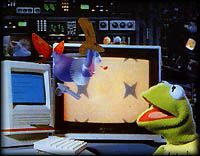 “I
would like to involve some computer animation down the road,” he
adds. “I’m really very enthusiastic about computer animation”.
“I
would like to involve some computer animation down the road,” he
adds. “I’m really very enthusiastic about computer animation”.
Henson moved into computer animation with “Waldo”, a character in THE JIM HENSON HOUR, which was animated by Pacific Data Images (PDI) as a real-time image.
“That’s exciting to me as a performance thing,” the puppeteer says, “because you get used to a different process when you’re thinking real time as opposed to going through 24 frames a second. When you have to think in terms of 24 frames a second, it’s more of an analytical way of getting there. A performance in real time is more of a ‘gut’ thing, so I think you can end up with a slightly different kind of performance.”
He says that Waldo is created by using an actual character in a low-resolution imaging system, then the tape is rendered into high-resolution and matted back into the final picture.
“To us, it’s just like doing puppetry,” he says.
Henson says that he hopes to do more projects with Lucasfilm and ILM too, and that the Disney buyout shouldn’t change his relationship with them. “George (Lucas) has always been a friend,” he says. “They did some of the effects on this 3-D film and they’re certainly people we’ll continue to work with.”
The Disney deal comes at a time of intense activity at the Henson operation.
“We have a couple of pilots for television,” Henson says. “We’ll have a television special on the characters going down to Disney World, which we’ll shoot in the spring, and there are several movie projects in development.”
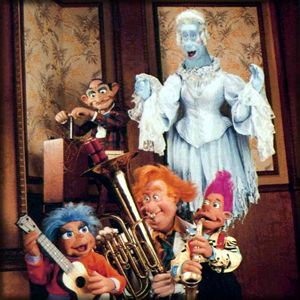 THE
GHOST OF FAFFNER HALL has just completed an HBO run, and Henson’s
sixth feature film, THE WITCHES – directed my Nicolas Roeg, based
on Roald Dahl’s children’s book and starring Angelica Houston
– opens soon. It mixes live action with puppetry. The company is
also producing GULLIVER’S TRAVELS as a four-hour miniseries for
NBC. And in the past year, Henson Associates licensed 700 new products
an a traveling arena show called “Where’s Animal?” The
company has even spawned traveling art shows, including, “The Art
of the Muppets”, “The World of Jim Henson – Art &
Animatronics”, and “Miss Piggy’s Art Masterpieces: Treasures
From the Kermitage Collection”. And Henson has even lent a director’s
helping hand to the TEENAGE MUTANT NINJA TURTLES.
THE
GHOST OF FAFFNER HALL has just completed an HBO run, and Henson’s
sixth feature film, THE WITCHES – directed my Nicolas Roeg, based
on Roald Dahl’s children’s book and starring Angelica Houston
– opens soon. It mixes live action with puppetry. The company is
also producing GULLIVER’S TRAVELS as a four-hour miniseries for
NBC. And in the past year, Henson Associates licensed 700 new products
an a traveling arena show called “Where’s Animal?” The
company has even spawned traveling art shows, including, “The Art
of the Muppets”, “The World of Jim Henson – Art &
Animatronics”, and “Miss Piggy’s Art Masterpieces: Treasures
From the Kermitage Collection”. And Henson has even lent a director’s
helping hand to the TEENAGE MUTANT NINJA TURTLES.
Back at the 3-D set, Henson watches as the technicians prepare for the Big Bang. As he talks a about the project, a prop man stops by to tell him that there is a hold while a “Danger Fireworks” sign must be replaced with one made from balsa wood. He talks about his family, most of who are involved with the company.
A Muppeteering Family
“My son John is working on this film. Brian is a puppeteer with me in England. My daughter Cheryl was a designer on some of the shows we did last year, and she’s also a puppeteer. Heather is my youngest, she has yet to come into it all, but she probably will in some way or another. And my oldest daughter is at Warner Bros.
“All my kids grew up in studios, grew up around the whole process that we do in both film and television. So I think they’re all show-business savvy. And it is the most entertaining business to work in. Everybody that works in it loves it.”
He talks about his children’s television: “I suspect that the best things being done now are being done for cable – a combination of Nickelodeon, Disney Channel and HBO are all doing some things. It’s difficult because if the networks do children’s television they have to pay for it with commercials. I don’t think that’s particularly a good idea, and you end up with commercial-driven entertainment. You want people to be doing children’s entertainment because you want it to be the best kind of programming for kids. Networks aren’t really designed to do that; they’re not designed to create that. They’re designed to create programming that gets people watching or buying products.
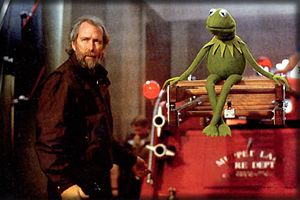 “You
get the wrong kind of driving motivation from the networks. That’s
why the cables are better, because they are only interested in doing good
programs for kids. They’re also interested in getting a lot of kids
watching, but it’s a better reason for being.”
“You
get the wrong kind of driving motivation from the networks. That’s
why the cables are better, because they are only interested in doing good
programs for kids. They’re also interested in getting a lot of kids
watching, but it’s a better reason for being.”
The prop man passes by carrying the new balsa-wood sign. Henson laughs as he notices that “Fireworks” is misspelled. He sends him back to make a correction.
Back in his director’s mode, Henson goes over to the camera position to check the shot again. The effect will be a fire truck backing through an exploding brick wall, with “Sweetums” and Kermit riding the ladder out over the audience. A primary camera shoots the scene and just above it the secondary shoots through a mirror to get a slightly offset image. The cameras are remotely operated and are in an enclosure to protect them from the explosion.
Behind the Barricades
The crew and visitors are ordered to get behind the protective barricades. Henson peers around a corner on the set.
On cue, pyrotechnics fill the foreground with smoke and sparks. Then the air cannons fire and the wall is blown to smithereens. Slivers of brick and wood fly over the barricades, back into an ivy-covered embankment. There’s a general feeling of “wow” on the set…followed by a burst of applause from the filmmakers.
“That was great”, a smiling Henson says as he calls for a playback on video assist. The crew mills around the TV set to look at the shot, then hurries to set up the next – a view through the “hole in the wall” toward the town square filled with balloon-carrying actors portraying Disney World tourists – before the light fades on the Burbank back lot. They discover that a sliver of brick has smashed through the protective glass and hit the lens of one of the cameras (watch for that effect in 3-D!) – but the film is undamaged. They rush to re-rig the cameras.
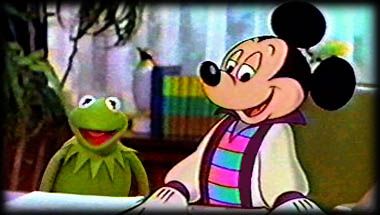 The
Muppet Master goes to the other side of the set to check details with
the crew. Son John, accompanied by some Muppet manipulators, comes over
to congratulate Dad on the shot. Henson chats amiably, his voice carrying
just a bit of that familiar “Kermit the Frog” twang. Jim Henson
Productions is calmly enfolded into Disney. Mickey is happy. Kermit is
happy. Miss Piggy is happy. And Jim Henson appears to be pretty happy
about the deal too.
The
Muppet Master goes to the other side of the set to check details with
the crew. Son John, accompanied by some Muppet manipulators, comes over
to congratulate Dad on the shot. Henson chats amiably, his voice carrying
just a bit of that familiar “Kermit the Frog” twang. Jim Henson
Productions is calmly enfolded into Disney. Mickey is happy. Kermit is
happy. Miss Piggy is happy. And Jim Henson appears to be pretty happy
about the deal too.
![]()
Editor's Note: This article was published a few weeks before Henson's untimely death on May 16, 1990. After several legal battles, Jim Henson Productions and Disney mutually ended merger negotiations in December 1990.
|
|
|
home | news | collectibles | articles | forum | guides | radio | cards | help
Fan site Muppet Central created by Phillip Chapman. Updates by Muppet
Central Staff. All Muppets, Bear
Muppet Central exists to unite fans of the Muppets around the world. |